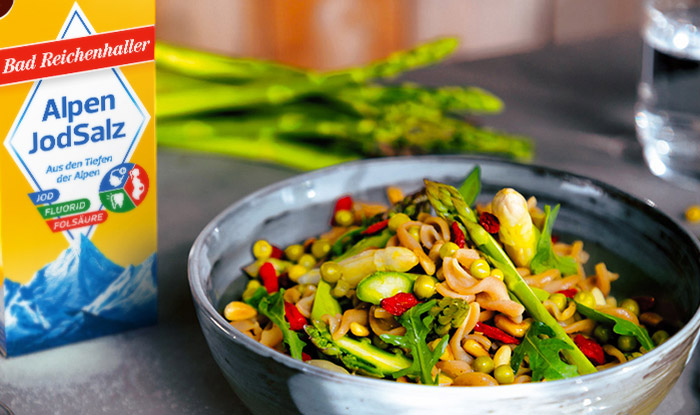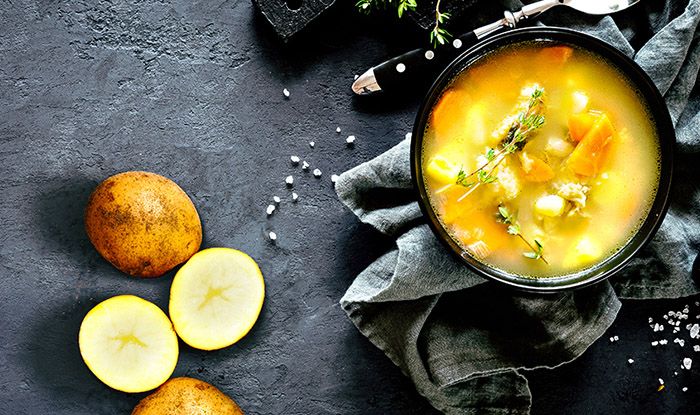Salty tips & tricks
We'll tell you what grandmother knew.
 1. How do you salt broths and stews?
1. How do you salt broths and stews?1. How do you salt broths and stews?
There are two options: should the flavor stay in the vegetables or meat, or should the flavor primarily be in the fluid? If you want to have a tasty piece of meat, you should simmer it in a salty broth – the taste of the meat will be enhanced by the aromas of the vegetables. If you would like a powerful broth, then you should wait till the end to salt it so that as much aroma from the meat and vegetables passes over to the broth as possible.
 2. How do you salt roast pork?
2. How do you salt roast pork?2. How do you salt roast pork?
Your roast pork will be especially crispy if you coat the crust with salt water five to ten minutes before the end of cooking or spray it with Bad Reichenhaller SprühSalz and roast briefly at high temperature. The salt draws the moisture out of the skin, making the crust wonderfully crispy.
 3. How do you salt dried legumes?
3. How do you salt dried legumes?3. How do you salt dried legumes?
Dried lentils, peas, beans, and other legumes should never be applied with salt or other ingredients containing salt. They will stay hard and will taste partly bland. It is best to soak them first in clear water and salt them after cooking.
 4. How do you salt salads?
4. How do you salt salads?4. How do you salt salads?
Salad that sits in the dressing for too long becomes soggy. Everyone has experienced this at some point – when the summer garden party lasts into the evening. The salad collapses because the salt absorbs the water from the leaves. This is why fresh, green lettuce should only be salted or dressing added just before serving so that is stays crispy as long as possible. Or you can simply round it off with a touch of Bad Reichenhaller Sprühsalz before eating.
 5. Why is salt added to desserts?
5. Why is salt added to desserts?5. Why is salt added to desserts?
Salty and sweet – is that a good combination? Not at first glance. Most dessert recipes say nothing about salt. However, many chefs and confectioners add a pinch of salt anyway because it intensifies the taste. Just give it a try... But please add it sparingly!
 6. How do you save an oversalted soup or broth?
6. How do you save an oversalted soup or broth?6. How do you save an oversalted soup or broth?
First the soup was too bland, now it is suddenly oversalted? No problem. Depending on the amount of salt, simply add a couple peeled and cubed potatoes to the broth and bring it to a boil again – the potatoes will absorb the salt.
 7. How do you save oversalted noodles?
7. How do you save oversalted noodles?7. How do you save oversalted noodles?
If noodles have been cooked in oversalted water, it helps to rinse them vigorously with hot water. If the noodles are cooked, pour them in a colander, rinse them with clear, hot water, and carefully shake them in the colander. This method can also be used for oversalted rice.
 8. How do I make fries crispy?
8. How do I make fries crispy?8. How do I make fries crispy?
Fries from the oven becomes especially crispy if they are coated with salt water before baking or – which is even faster – simply sprayed with Bad Reichenhaller SprühSalz.
 9. How long can salt be stored?
9. How long can salt be stored?9. How long can salt be stored?
Pure salt can be stored indefinitely. Only additives such as iodine can break down after long periods of storage. This is why a best before date is required for iodized table salt according to food law – under certain conditions, the iodine content may not match the amount declared on the packaging.
Bad Reichenhaller AlpenJodSalz is still completely fit for consumption even after the best before date expires, and there is no health risk. However, people who are recommended to consume food containing iodine due to hyperthyroidism are advised to use AlpenJodSalz with a valid best before date.
 10. What is the best way to store salt?
10. What is the best way to store salt?10. What is the best way to store salt?
Salt should never be stored in metal containers. In conjunction with humidity, salt can even attack precious metals and cause them to corrode. Glass or ceramic containers are ideally suitable for storing salt.
Since salt absorbs moisture from the air, it can get lumpy. This means that opened salt packages should not be kept near the stove or steaming pots, but rather in a closed cupboard or in an air-tight container.